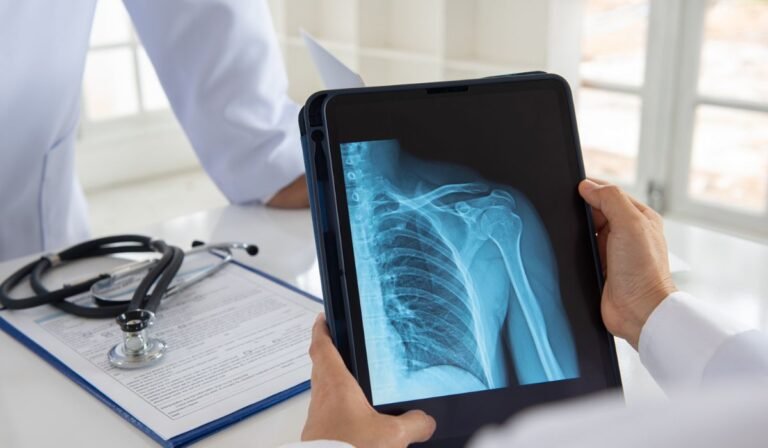When unexpected injuries or illnesses strike, urgent care centers provide fast, reliable access to medical services that might not require a trip to the emergency room. These centers’ efficiency is significantly enhanced by offering on-site X-ray and laboratory services, allowing patients to receive comprehensive care in a single location.
For those needing timely medical attention outside of regular hours, weekend urgent care services can be a critical resource for families and individuals navigating minor health crises.
Beyond convenience, on-site diagnostics in urgent care contribute to better clinical outcomes and reduce the burden on hospital emergency departments. Patients benefit from swift diagnoses and targeted treatments while reducing the need for multiple appointments or delayed care—key considerations for anyone seeking prompt, patient-centered solutions for their health concerns.
Benefits of On-Site Diagnostic Services
- Immediate Results: On-site X-ray and lab services allow healthcare professionals to diagnose conditions promptly, which means patients can receive treatment recommendations during the same visit. This speed is particularly important when delays could worsen symptoms or complications.
- Enhanced Convenience: Urgent care centers reduce patients’ stress and travel time by eliminating referrals or trips to specialty facilities. This is especially valuable for families with children, elderly adults, or anyone with limited mobility.
- Cost Efficiency: Consolidated diagnostic and treatment services help lower healthcare costs by reducing duplicate testing and unnecessary follow-up visits. This consolidation can make a significant financial difference for patients without insurance or those with high-deductible plans.
Common On-Site Diagnostic Tests
Most urgent care centers with on-site diagnostics offer a focused array of tests that address the most common acute illnesses and injuries. Some of these include:
- X-Rays: Indispensable for evaluating suspected fractures, joint sprains, dislocations, and soft tissue injuries. They are also valuable in assessing internal conditions, like pneumonia or kidney stones.
- Laboratory Tests: These can range from basic blood work and urinalysis to rapid antigen or PCR testing for respiratory infections such as strep throat, influenza, and COVID-19. Immediate, accurate results help clinicians tailor treatments on the spot.
According to CDC statistics, quicker access to diagnostics helps reduce wait times and patient volumes in already-burdened emergency rooms, underscoring the importance of expanding these services in urgent care settings.
Impact on Patient Outcomes
The direct influence of on-site diagnostics on patient outcomes cannot be overstated. For example, when a patient presents with chest pain, a same-visit X-ray excludes or confirms life-threatening issues such as pneumonia or, in some cases, heart failure. This speed enables healthcare providers to intervene rapidly and appropriately, often preventing unnecessary hospital admissions or transfers.
For sports injuries or minor traumas, immediate imaging rules out more significant injury, and targeted lab tests can quickly identify infections or metabolic imbalances, ensuring patients receive the care suited to their needs.
Case Study: Enhancing Patient Care
Consider a scenario where a patient arrives at an urgent care center with a swollen, painful ankle after a fall. With on-site X-ray services, clinicians can assess the injury within minutes, confirm a fracture, and proceed with immobilization, pain management, and a referral to an orthopedic specialist—all before the patient leaves the facility. This single-visit approach significantly reduces anxiety, speeds up the healing process, and improves overall patient satisfaction compared to locations lacking integrated diagnostic services.
Challenges and Considerations
- Equipment Costs: Outfitting urgent care clinics with X-ray machines and modern laboratory equipment is a substantial investment. Ongoing maintenance and calibration are also necessary to ensure accurate results.
- Staff Training: It is crucial to ensure that all staff are proficient in operating diagnostic equipment and interpreting results. This demands continuous education and oversight to maintain high standards of care.
- Regulatory Compliance: Urgent care centers must follow stringent health regulations concerning radiation safety, patient privacy, and quality control in lab testing to protect patients and staff. Regulatory oversight is particularly important, as lapses can lead to misdiagnosis or safety risks.
Future Trends in Urgent Care Diagnostics
- Telemedicine Integration: The combination of on-site diagnostic capability with telehealth consultations will continue to expand, especially in rural or underserved areas. Patients can have lab or imaging tests performed locally and review results promptly with remote specialists.
- Advanced Imaging Technologies: Newer, faster, and more accurate imaging modalities are gradually becoming accessible in the urgent care setting. For example, digital radiography and portable ultrasound devices provide enhanced diagnostic power at the point of care.
- Point-of-Care Testing: The market for rapid, CLIA-waived laboratory tests is booming, allowing clinicians to test for an ever-growing range of conditions right in the exam room.
Conclusion
On-site X-ray and laboratory services have transformed urgent care centers into highly efficient, comprehensive healthcare hubs. Their capacity to provide immediate, integrated diagnostics improves patient convenience, reduced healthcare costs, and better health outcomes.
As urgent care continues to evolve—embracing new technology, telemedicine, and point-of-care testing—these centers will play an increasingly important role in the broader healthcare ecosystem, delivering responsive and effective care for communities in need.
